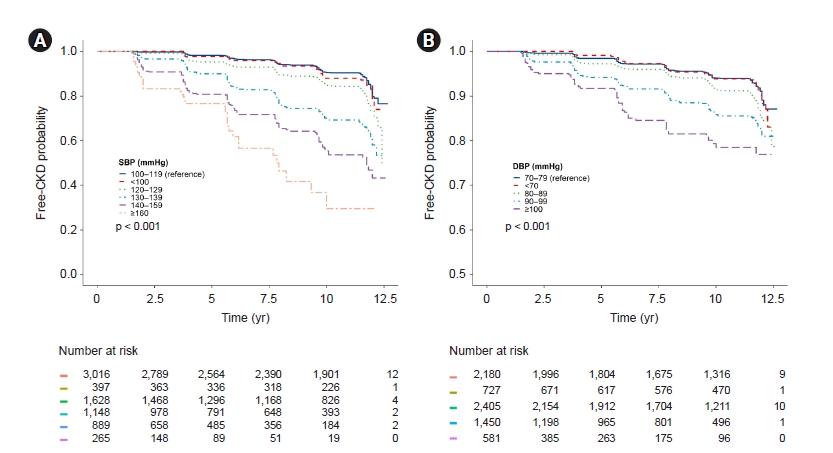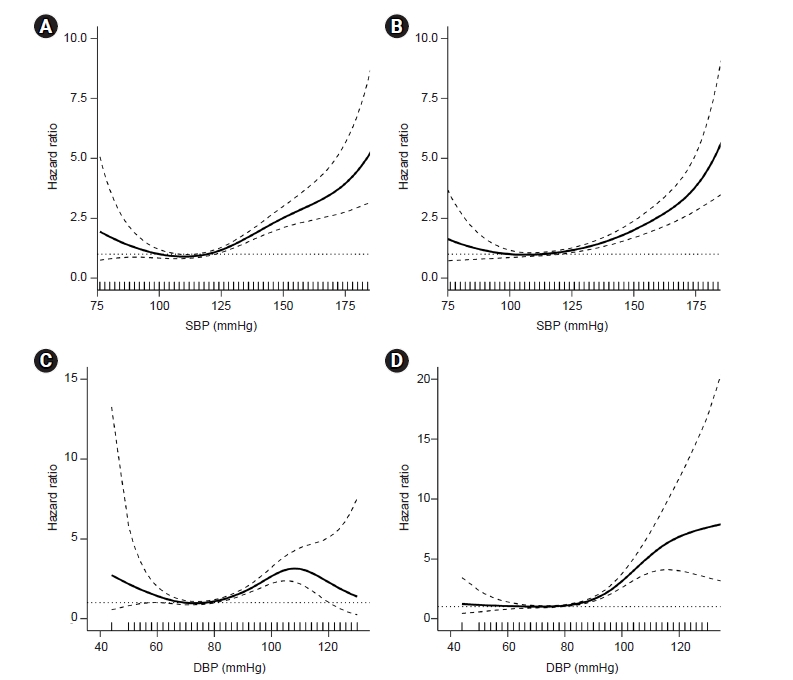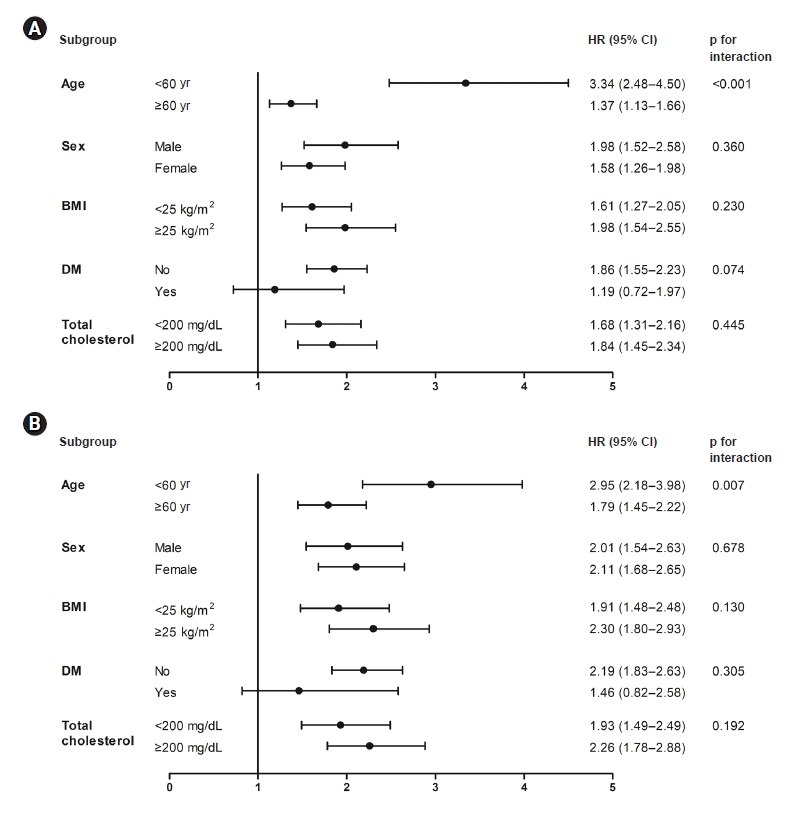| Kidney Res Clin Pract > Volume 41(1); 2022 > Article |
|
Abstract
Background
Methods
Results
Notes
Authors’ contributions
Conceptualization: HK, DCH
Data curation: HK, HL, SHK
Formal analysis, Visualization: HK, HL, JSJ
Funding acquisition: HK
Methodology: HK, HL, HN
Project administration: HK
Writing–original draft: HL
Writing–review & editing: All authors
All authors read and approved the final manuscript.
Acknowledgments
Figure 1.
Kaplan-Meier curves for the development of CKD according to baseline (A) SBP and (B) DBP.

Figure 2.
Restricted cubic spline curve for the incident CKD risk according to (A) baseline SBP, (B) time-updated SBP, (C) baseline DBP, and (D) time-updated DBP.

Figure 3.
Subgroup analyses and interaction terms for incident CKD according to time-updated (A) SBP and (B) DBP.

Table 1.
Data are expressed as counts (%) for categorical variables and as means ± standard deviations for continuous variables.
DBP, diastolic blood pressure; eGFR, estimated glomerular filtration rate; HDL-C, high-density lipoprotein cholesterol; LDL-C, low-density lipoprotein cholesterol; SBP, systolic blood pressure.
Table 2.
| Variable |
Baseline |
Time-varying |
||||||
|---|---|---|---|---|---|---|---|---|
|
Unadjusted |
Adjusteda |
Unadjusted |
Adjustedb |
|||||
| HR (95% CI) | p-value | HR (95% CI) | p-value | HR (95% CI) | p-value | HR (95% CI) | p-value | |
| SBP (mmHg) | ||||||||
| <100 | 1.13 (0.74–1.72) | 0.57 | 1.66 (1.08–2.54) | 0.02 | 0.84 (0.56–1.25) | 0.39 | 1.12 (0.75–1.67) | 0.57 |
| 100–119 | (Reference) | (Reference) | (Reference) | (Reference) | ||||
| 120–129 | 1.62 (1.28–2.05) | <0.001 | 1.35 (1.06–1.71) | 0.01 | 1.16 (0.90–1.48) | 0.25 | 0.93 (0.73–1.19) | 0.55 |
| 130–139 | 2.99 (2.37–3.77) | <0.001 | 1.96 (1.54–2.48) | <0.001 | 2.13 (1.69–2.69) | <0.001 | 1.39 (1.10–1.77) | 0.007 |
| 140–159 | 4.98 (3.93–6.30) | <0.001 | 2.66 (2.08–3.40) | <0.001 | 3.18 (2.53–3.99) | <0.001 | 1.79 (1.40–2.28) | <0.001 |
| ≥160 | 9.19 (6.45–13.11) | <0.001 | 3.78 (2.62–5.47) | <0.001 | 7.13 (5.28–9.62) | <0.001 | 3.22 (2.35–4.40) | <0.001 |
| DBP (mmHg) | ||||||||
| <70 | 1.02 (0.74–1.41) | 0.90 | 1.44 (1.04–2.01) | 0.03 | 0.99 (0.74–1.31) | 0.93 | 1.05 (0.79–1.40) | 0.73 |
| 70–79 | (Reference) | (Reference) | (Reference) | (Reference) | ||||
| 80–89 | 1.46 (1.17–1.81) | 0.001 | 1.35 (1.09–1.69) | 0.007 | 1.21 (0.98–1.50) | 0.07 | 1.19 (0.97–1.47) | 0.10 |
| 90–99 | 2.31 (1.83–2.92) | <0.001 | 1.90 (1.50–2.40) | <0.001 | 1.89 (1.49–2.38) | <0.001 | 1.88 (1.48–2.37) | <0.001 |
| ≥100 | 3.94 (2.94–5.29) | <0.001 | 3.00 (2.22–4.05) | <0.001 | 3.79 (2.84–5.05) | <0.001 | 4.30 (3.20–5.76) | <0.001 |
CI, confidence interval; DBP, diastolic blood pressure; HR, hazard ratio; SBP, systolic blood pressure.
Table 3.
| Variable |
Baseline |
Time-varying |
||||||
|---|---|---|---|---|---|---|---|---|
|
Unadjusted |
Adjusteda |
Unadjusted |
Adjustedb |
|||||
| HR (95% CI) | p-value | HR (95% CI) | p-value | HR (95% CI) | p-value | HR (95% CI) | p-value | |
| SBP (mmHg) | ||||||||
| <100 | 0.31 (0.13–0.76) | 0.01 | 0.40 (0.16–0.99) | 0.05 | 0.56 (0.31–1.02) | 0.06 | 0.69 (0.38–1.26) | 0.23 |
| 100–119 | (Reference) | (Reference) | (Reference) | (Reference) | ||||
| 120–129 | 1.63 (1.24–2.14) | <0.001 | 1.36 (1.03–1.79) | 0.03 | 1.51 (1.14–2.00) | 0.004 | 1.26 (0.95–1.69) | 0.11 |
| 130–139 | 2.81 (2.14–3.69) | <0.001 | 1.93 (1.45–2.55) | <0.001 | 2.20 (1.65–2.94) | <0.001 | 1.61 (1.19–2.18) | 0.002 |
| 140–159 | 3.51 (2.61–4.72) | <0.001 | 2.11 (1.55–2.89) | <0.001 | 3.39 (2.57–4.48) | <0.001 | 2.34 (1.72–3.17) | <0.001 |
| ≥160 | 6.19 (3.97–9.65) | <0.001 | 3.19 (2.01–5.05) | <0.001 | 4.58 (2.98–7.06) | <0.001 | 2.88 (1.84–4.50) | <0.001 |
| DBP (mmHg) | ||||||||
| <70 | 0.64 (0.40–1.02) | 0.06 | 0.79 (0.50–1.27) | 0.33 | 0.71 (0.48–1.05) | 0.08 | 0.80 (0.54–1.19) | 0.27 |
| 70–79 | (Reference) | (Reference) | (Reference) | (Reference) | ||||
| 80–89 | 1.28 (0.98–1.67) | 0.07 | 1.16 (0.89–1.51) | 0.29 | 1.15 (0.89–1.49) | 0.28 | 1.04 (0.80–1.35) | 0.76 |
| 90–99 | 2.18 (1.66–2.87) | <0.001 | 1.70 (1.29–2.26) | <0.001 | 1.93 (1.46–2.55) | <0.001 | 1.69 (1.26–2.25) | <0.001 |
| ≥100 | 3.49 (2.47–4.94) | <0.001 | 2.49 (1.74–3.55) | <0.001 | 3.92 (2.81–5.47) | <0.001 | 3.31 (2.34–4.70) | <0.001 |
CI, confidence interval; DBP, diastolic blood pressure; HR, hazard ratio; SBP, systolic blood pressure.
References
- TOOLS
-
METRICS

- ORCID iDs
-
Haekyung Lee

https://orcid.org/0000-0001-5211-3961Soon Hyo Kwon

https://orcid.org/0000-0002-4114-4196Jin Seok Jeon

https://orcid.org/0000-0003-2421-2289Hyunjin Noh

https://orcid.org/0000-0002-1904-1684Dong Cheol Han

https://orcid.org/0000-0002-8835-8642Hyoungnae Kim

https://orcid.org/0000-0002-5359-0214 - Related articles
-
Diabetic kidney disease treatment: new perspectives2022 September;41(Suppl 2)
Blood pressure management in treatment-naïve hypertensive patients2022 January;41(1)



 PDF Links
PDF Links PubReader
PubReader ePub Link
ePub Link Full text via DOI
Full text via DOI Download Citation
Download Citation Supplement 1
Supplement 1 Print
Print















